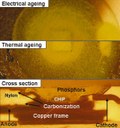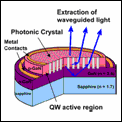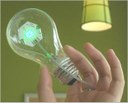Trends
Trends
Technology
|
Oct 15, 2010
Epistar Red-Orange LED Chips Set Efficacy Record in the Lab
 Epistar announces today the successful development of a new generation of Aquarius-series AlGaInP LEDs emitting at an efficacy 26 percent higher than the previously announced Mar. 15, 2010 record.
Read more »
Epistar announces today the successful development of a new generation of Aquarius-series AlGaInP LEDs emitting at an efficacy 26 percent higher than the previously announced Mar. 15, 2010 record.
Read more »
Technology
|
Oct 04, 2010
Using Nanostructures to Improve LED Light Emission
 Application of nanosphere lithography to create uniform surface roughness on an optical device sample promotes light extraction and collection efficiency. In recent years, nanopattern definition has become a subject of extensive exploration owing to its ability to improve device performance in electronics and optoelectronics. The literature proposes a variety of techniques, including electron-beam lithography, which gives uniform nanopatterns but is expensive, and self-assembled metal nanomasks, which scatter nonuniformly on the sample. As an alternative, we have developed a technology called nanosphere lithography that creates nanopatterns by spin-coating a monolayer of nanospheres on top of the device surface. We have used the technology to fabricate nanopatterns on gallium nitride (GaN)-based LEDs to improve light extraction and collection efficiency.
Read more »
Application of nanosphere lithography to create uniform surface roughness on an optical device sample promotes light extraction and collection efficiency. In recent years, nanopattern definition has become a subject of extensive exploration owing to its ability to improve device performance in electronics and optoelectronics. The literature proposes a variety of techniques, including electron-beam lithography, which gives uniform nanopatterns but is expensive, and self-assembled metal nanomasks, which scatter nonuniformly on the sample. As an alternative, we have developed a technology called nanosphere lithography that creates nanopatterns by spin-coating a monolayer of nanospheres on top of the device surface. We have used the technology to fabricate nanopatterns on gallium nitride (GaN)-based LEDs to improve light extraction and collection efficiency.
Read more »
Technology
|
Sep 08, 2010
Philips Demonstrates World’s First Mains-Powered White-Light OLED Module
 Scientists from Philips Research have developed the first-ever organic light emitting diode (OLED) module that can be powered directly from a mains electricity supply. The prototype opens the door to OLED systems that can be directly plugged into standard power outlets without the need for bulky power management circuitry. This will reduce the bill of materials and simplify luminaire design for future OLED-based systems aimed at mass-market general illumination applications.
Read more »
Scientists from Philips Research have developed the first-ever organic light emitting diode (OLED) module that can be powered directly from a mains electricity supply. The prototype opens the door to OLED systems that can be directly plugged into standard power outlets without the need for bulky power management circuitry. This will reduce the bill of materials and simplify luminaire design for future OLED-based systems aimed at mass-market general illumination applications.
Read more »
Technology
|
Sep 06, 2010
Optek - Thermal Management - Introduction
Optek presents the research on heat management.
Read more »
Technology
|
Aug 06, 2010
LED Failure Modes and Methods for Analysis
 LED’s open the way to new applications and markets in various different fields with a broad spectrum of requirements. Beneath other beneficial characteristics, in general, LED’s provide a high reliability, and a lifetime of more than 50;000 hours can be reached. Poor workmanship in manufacturing and unfavorable operational conditions may reduce the reliability significantly. To avoid failures or to achieve fast resolutions of existing problems a good knowledge of the failure mechanisms and suitable analytical methods is required. Objective of this article is to provide an overview of state of the art techniques in LED-Failure analysis.
Read more »
LED’s open the way to new applications and markets in various different fields with a broad spectrum of requirements. Beneath other beneficial characteristics, in general, LED’s provide a high reliability, and a lifetime of more than 50;000 hours can be reached. Poor workmanship in manufacturing and unfavorable operational conditions may reduce the reliability significantly. To avoid failures or to achieve fast resolutions of existing problems a good knowledge of the failure mechanisms and suitable analytical methods is required. Objective of this article is to provide an overview of state of the art techniques in LED-Failure analysis.
Read more »
Technology
|
Aug 06, 2010
LED Source Modeling Method Evaluations
 Producing accurate simulations of LED based optical systems requires accurate source models. This means the source models must not only produce the correct distribution of light in a far field measurement, they must also produce the correct near field behavior since secondary LED optics are often employed in very close proximity to the LED. Accurate simulations are vital to the design process especially with lens optics commonly used on LEDs given the high cost and long lead times for lens tooling. The data presented in this paper is a direct result of the lessons learned by one manufacturer about the importance of simulation accuracy.
Read more »
Producing accurate simulations of LED based optical systems requires accurate source models. This means the source models must not only produce the correct distribution of light in a far field measurement, they must also produce the correct near field behavior since secondary LED optics are often employed in very close proximity to the LED. Accurate simulations are vital to the design process especially with lens optics commonly used on LEDs given the high cost and long lead times for lens tooling. The data presented in this paper is a direct result of the lessons learned by one manufacturer about the importance of simulation accuracy.
Read more »
Technology
|
Aug 04, 2010
Thermally Activated Degradation of Phosphor-Converted White LEDs
 The increasing performances and long lifetime of High Brightness LEDs are still limited by the high temperatures involved. This work shows the results of several accelerated lifetime tests on 1W white LEDs. Two different tests have been carried out: a pure thermal storage at different temperatures and an electrical aging obtained by biasing the LEDs. The impact of high temperatures has been evaluated in terms of flux decay, chromatic properties modification, increase of forward voltage and thermal resistance. A picture of the main degradation mechanisms detected has been provided in detail.
Read more »
The increasing performances and long lifetime of High Brightness LEDs are still limited by the high temperatures involved. This work shows the results of several accelerated lifetime tests on 1W white LEDs. Two different tests have been carried out: a pure thermal storage at different temperatures and an electrical aging obtained by biasing the LEDs. The impact of high temperatures has been evaluated in terms of flux decay, chromatic properties modification, increase of forward voltage and thermal resistance. A picture of the main degradation mechanisms detected has been provided in detail.
Read more »
Technology
|
Jul 29, 2010
Method May Help Optimize Light-emitting Semiconductors
Technology
|
Jul 29, 2010
Aluminum Nitride Light Emitting Diodes with the Shortest Wavelength towards Dioxin, PCB Decomposition Technology
 Nippon Telegraph and Telephone Corporation (NTT) has observed light of 210-nm wavelength from aluminum nitride (AlN) light emitting diodes (LED).
Read more »
Nippon Telegraph and Telephone Corporation (NTT) has observed light of 210-nm wavelength from aluminum nitride (AlN) light emitting diodes (LED).
Read more »
Technology
|
Jul 29, 2010
Photonics crystals improve LED efficiency
 A 50% increase in efficiency is a significant stride toward being viable sources for solid-state lighting.
Read more »
A 50% increase in efficiency is a significant stride toward being viable sources for solid-state lighting.
Read more »
Technology
|
Jul 29, 2010
Paint-on semiconductor outperforms chips
Technology
|
Jul 29, 2010
Novel Nano-Etched Cavity Makes LEDs 7 Times Brighter
 Researchers at the National Institute of Standards and Technology (NIST) have made semiconductor light-emitting diodes (LEDs) more than seven times brighter by etching nanoscale grooves in a surrounding cavity to guide scattered light in one direction.
Read more »
Researchers at the National Institute of Standards and Technology (NIST) have made semiconductor light-emitting diodes (LEDs) more than seven times brighter by etching nanoscale grooves in a surrounding cavity to guide scattered light in one direction.
Read more »
Technology
|
Jul 29, 2010
Rensselaer researchers aim to close 'green gap' in LED technology
 Troy, N.Y. - A team of researchers from Rensselaer Polytechnic Institute has received $1.8 million in federal funding to improve the energy efficiency of green light-emitting diodes (LEDs).
Read more »
Troy, N.Y. - A team of researchers from Rensselaer Polytechnic Institute has received $1.8 million in federal funding to improve the energy efficiency of green light-emitting diodes (LEDs).
Read more »
Technology
|
Jul 29, 2010
Japanese scientists have proposed a solution to the puzzle of why blue light-emitting diodes are so bright
 Despite huge commercial success, until now the reason for the unusual brightness has not been known. The material they are made from - indium gallium nitride - can only be fabricated to such a poor quality that it would not be expected to emit much light.
Read more »
Despite huge commercial success, until now the reason for the unusual brightness has not been known. The material they are made from - indium gallium nitride - can only be fabricated to such a poor quality that it would not be expected to emit much light.
Read more »
Technology
|
Jul 29, 2010
QD Vision chief technologist Seth Coe-Sullivan named top innovator by Tech Review Magazine: MIT journal honors 35 top scientific and technology innovators under the age of 35
WATERTOWN, MA, SQD Vision, Inc. announced that Cofounder and Chief Technologist Seth Coe-Sullivan has been recognized by Technology Review as one of the world’s Top Science and Technology Innovators under the age of 35 for his breakthrough work in quantum dot LED performance and manufacturing process technology.
Read more »
Technology
|
Jul 29, 2010
Organic semiconductors make cheap, flexible photovoltaics and LEDs
Technology
|
Jul 29, 2010
QD Vision improves quantum-dot LED performance
WATERTOWN, Mass., QD Vision, Inc., announced it has achieved significant improvements in efficiency of its red quantum-dot light-emitting devices (QD-LEDs). The trend of improvements in brightness, color, resolution and other metrics continue to advance QD- LEDs toward best-in-class performance levels among display technologies.
Read more »
Technology
|
Jul 29, 2010
Shimei Semiconductor grows blue LED on silicon wafer
Technology
|
Jul 29, 2010
MIT chemist studies how electrons behave
 New spin on electrons could improve lights, other devices. Troy Van Voorhis likes to watch how things work. This natural curiosity led to his current research on the behavior of electrons and how they function in various molecular systems, including artificial photosynthesis.
Read more »
New spin on electrons could improve lights, other devices. Troy Van Voorhis likes to watch how things work. This natural curiosity led to his current research on the behavior of electrons and how they function in various molecular systems, including artificial photosynthesis.
Read more »
Technology
|
Jul 29, 2010
Team awarded for better bulb discovery
A team of scientists at Vanderbilt University have been given an award from Popular Mechanics magazine for a discovery that could someday replace the common light bulb, the researchers say.
Read more »
Technology
|
Jul 29, 2010
UC Santa Barbara Researchers Set New Records in Energy Efficient Light Emitting Diodes
Santa Barbara, California USA-- Researchers at UC Santa Barbaras Solid State Lighting & Display Center and the Japan Science & Technology Agencys Exploratory Research for Advanced Technology program (JST ERATO) have set new records for nonpolar and semipolar light emitting diode (LED) efficiency.
Read more »
Technology
|
Jul 29, 2010
Cheaper LEDs from breakthrough in ZnO nanowire research
 Engineers at UC San Diego have synthesized a long-sought semiconducting material that may pave the way for an inexpensive new kind of light emitting diode (LED) that could compete with today's widely used gallium nitride LEDs, according to a new paper in the journal Nano Letters.
Read more »
Engineers at UC San Diego have synthesized a long-sought semiconducting material that may pave the way for an inexpensive new kind of light emitting diode (LED) that could compete with today's widely used gallium nitride LEDs, according to a new paper in the journal Nano Letters.
Read more »
Technology
|
Jul 29, 2010
Bright white beetle dazzles scientists
 An obscure species of beetle could teach us how to produce brilliant white ultra-thin materials, according to a research team led by the University of Exeter.
Read more »
An obscure species of beetle could teach us how to produce brilliant white ultra-thin materials, according to a research team led by the University of Exeter.
Read more »
Technology
|
Jul 29, 2010
Cyberlux Corporation defines breakthrough hybrid organic / inorganic lighting capability
Company’s Exclusive Rights to Hybrid Lighting Technology from University of California-Santa Barbara Combined with Exclusive Rights to Scattered Photon Extraction Technology from Rensselaer Polytechnic Institute Creates Foundation for Sustainable Competitive Advantage.
Read more »
Technology
|
Jul 29, 2010
Philips Lumileds LED technology breakthrough fundamentally solves efficiency losses at high drive currents
 San Jose, CA — Philips Lumileds today announced it has fundamentally solved the problem of “droop”, a phenomenon common to white power LEDs in which efficacy (lumens per watt) decreases as current increases.
Read more »
San Jose, CA — Philips Lumileds today announced it has fundamentally solved the problem of “droop”, a phenomenon common to white power LEDs in which efficacy (lumens per watt) decreases as current increases.
Read more »
Technologies | Measurement
|
Jul 29, 2010
MaxMile Technologies introduces EpiEL mapping system optimized for nitride-based LED applications
 MaxMile Technologies, LLC at Lexington has recently introduced a EpiEL mapping system (EpiEL-700) which is optimized for nitride-based LED applications.
Read more »
MaxMile Technologies, LLC at Lexington has recently introduced a EpiEL mapping system (EpiEL-700) which is optimized for nitride-based LED applications.
Read more »
Technology
|
Jul 29, 2010
SDK develops new crystal growth technology for GaN-based blue/white LEDs
 Showa Denko K.K. (SDK) has developed a new process for making high-quality compound semiconductors based on gallium nitride (GaN) and other nitrides to meet growing demand mainly for use in blue/white LEDs.
Read more »
Showa Denko K.K. (SDK) has developed a new process for making high-quality compound semiconductors based on gallium nitride (GaN) and other nitrides to meet growing demand mainly for use in blue/white LEDs.
Read more »
Technology
|
Jul 29, 2010
Arrowhead subsidiary collaborates with Kyma Technologies to reduce the cost of blue lasers and blue LEDs
PASADENA, Calif., Arrowhead Research Corporation (NASDAQ ARWR) announced today that its majority-owned subsidiary, Aonex Technologies, Inc. has entered into a collaborative agreement with Kyma Technologies, Inc., a producer and marketer of semiconductor products, to develop materials to reduce the cost of gallium nitride (GaN)-based devices such as blue laser diodes and blue light emitting diodes (LEDs).
Read more »
Technology
|
Jul 29, 2010
Rensselaer researchers create world's first ideal anti-reflection coating
 Troy, N.Y. -- A team of researchers from Rensselaer Polytechnic Institute has created the world’s first material that reflects virtually no light. Reporting in the March issue of Nature Photonics, they describe an optical coating made from the material that enables vastly improved control over the basic properties of light.
Read more »
Troy, N.Y. -- A team of researchers from Rensselaer Polytechnic Institute has created the world’s first material that reflects virtually no light. Reporting in the March issue of Nature Photonics, they describe an optical coating made from the material that enables vastly improved control over the basic properties of light.
Read more »
Technology
|
Jul 29, 2010
New coating is virtual black hole for reflections
 Researchers have created an anti-reflective coating that allows light to travel through it, but lets almost none bounce off its surface.
Read more »
Researchers have created an anti-reflective coating that allows light to travel through it, but lets almost none bounce off its surface.
Read more »
